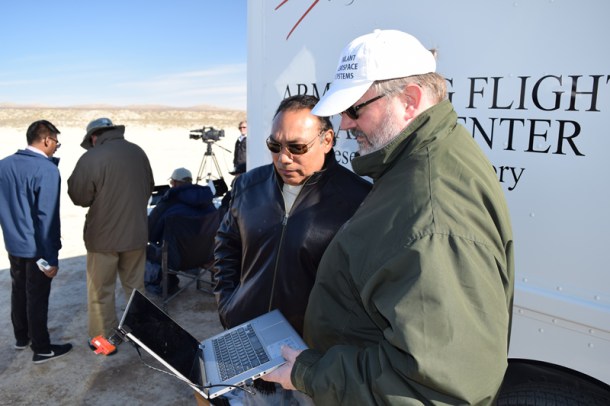NASA Senior Flight Engineer Dr. Ricardo Arteaga and Vigilant Aerospace CEO Kraettli Epperson on-site for past line-of-sight testing at NASA Armstrong, Image courtesy Vigilant
Vigilant Aerospace, below the commentary of the FAA and NASA, has accomplished past visual-line-of-sight (BVLOS) flight testing of its new FlightHorizon collision avoidance system for drones. The firm has launched a 90 second video explaining the method, software program, and outcomes.
The profitable completion of these exams would appear to point one other step ahead in the direction of laws that will enable BVLOS flight as half of common industrial drone operation. Vigilant’s flight security software program – FlightHorizon – relies on a NASA patent and prototype, to which they maintain the unique license.
Tests have been carried out by Vigilant at NASA Armstrong Flight Research Center within the Mojave desert. Representatives from the FAA, FCC, NASA and airfield security officers have been all current as skilled drone operators flew practically 100 flights with two DJI Phantom four drones outfitted with aviation transponders and a laptop computer operating the FlightHorizon software program.
The software program offers drone pilots with a visible map of their plane’s location and the situation of different close by plane and offers air site visitors alerts and collision warnings by monitoring the drone and all of the plane round it for tens of miles. The exams concerned 18 encounter eventualities, together with past line-of-sight flights through which the plane have been flown at one another from out of sight. The software program proved profitable in exams: FlightHorizon detected and tracked 100% of the air site visitors and warned of all potential collisions.
“FlightHorizon UAS™ is designed to meet the upcoming RTCA SC-228 Phase II Minimum Operating Standards (MOPS)…” says the corporate. “It is also intended to help unmanned operators obtain a beyond visual line-of-sight waiver under Section 107.200 of the new sUAS Part 107 rules. The product is based on an exclusively licensed patent and software suite developed and tested by NASA at Armstrong Flight Research Center with FAA observation.”
BVLOS flight is just not allowed below at present laws, though FAA Administrator Michael Huerta has promised motion on BVLOS laws quickly.

